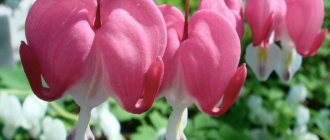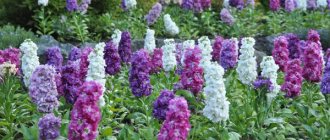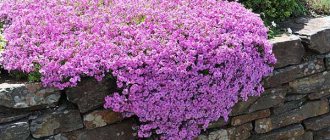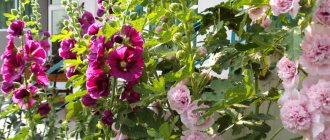Nasturtium is a flower beloved by Russian gardeners, which looks extremely impressive and bears delicious fruits that are used to prepare various dishes. In addition to impressive quality characteristics, this plant is unpretentious and feels comfortable in almost any climatic conditions. Another advantage of the plant is that it is actively used to treat various ailments. In this material we will talk about how nasturtium grows, planting and care in open ground will be discussed in detail.
Nasturtium: planting and care in open ground
What every gardener needs to know about nasturtium
All varietal varieties of the crop in question are divided into two main categories
- annuals;
- perennial.
As a rule, the plant is represented by a long vine, decorated with succulent flowers and leaves, or grows like a subshrub. Nasturtium flowers exude a distinct and pleasant aroma for the human sense of smell, and there are buds:
- semi-double;
- terry.
Most often, each bud opens in the form of five petals, some varieties have more, starting from a cavity similar to a funnel, inside which the nectar of the flower collects. The traditional color scheme of nasturtium varies in the following shades:
- yellow;
- red;
- orange.
This culture is grown everywhere in Russia
The plant bears fruit in small formations consisting of three lobes, inside each of which the seeds ripen.
Both the green part of the plant and its flowers are actively used for the preparation of various medicines, and the fruits are eaten as part of various dishes, or solo.
Prices for nasturtium seeds
nasturtium seeds
Beneficial features
Nasturtium is interesting not only as an ornamental plant.
It is edible, and all its parts except the roots are added to dishes:
- Fresh shoots and young leaves, which have a piquant taste and contain an abundance of vitamin C, are used in salads, minced meat, soups and drinks.
- dietary dishes are sprinkled with crushed seeds instead of seasoning
- the seeds are suitable for making edible oil, which tastes similar to mustard
- flowers and leaves decorate salads and sandwiches
- the fruits are used in pickled form, which taste similar to capers
- Due to their strong aroma, dried flowers are used in tea mixtures
The rich chemical composition allows the plant to be used in folk medicine and cooking.
The plant is not forgotten in folk medicine, as it contains many useful substances. This is a whole group of vitamins, of which iron and iodine are of particular value. The juice is rich in organic acids. In addition, nasturtium is classified as a herbal antibiotic. It is mainly used in the form of decoctions and infusions.
The use of nasturtium is associated with a number of diseases. It is useful for:
- avitaminosis
- anemia
- skin diseases
- burns (use juice)
- rheumatism
- diabetes mellitus
- colds of various natures
A special substance is isolated from the essential oils of nasturtium - tropolein, from which drugs are created for the treatment of chronic coronary insufficiency.
This beautiful and fragrant plant is not forgotten by cosmetologists . It is part of ointments, creams, balms made for skin and hair. The tincture has a good effect on problematic facial skin and is used as a hair growth stimulator. Rinse the curls with decoctions to give them shine and silkiness.
Nasturtium: planting and care
To grow nasturtium yourself, you need to read this article and follow the steps described in it in practice, which, in fact, is far from difficult. Let's begin by looking at step-by-step instructions for planting and caring for nasturtiums.
Step No. 1 - sow nasturtium in the ground or grow seedlings
As is clear from the name of the first step, nasturtium is a plant that is sown directly into the ground or pre-harvested in the form of:
- seedlings;
- Cherenkov.
As we have already said, it is inherently unpretentious, and therefore does not require preliminary preparation of seedlings for planting, but you can play it safe by letting the seedlings get stronger in advance.
Nasturtium seedlings
Propagation by seeds
To propagate nasturtium, the so-called generative method is most often used, that is, planting seeds. They are rather large in this plant and immediately sink into the open soil.
Planting times will vary depending on the climatic conditions of your region:
- Southerners can start sowing the land with nasturtiums at the end of April;
- residents of central Russia in mid-May;
- residents of the northern regions at the end of May.
The main condition regarding the timing is the following: by the time the seeds are planted, the frosts must be gone irrevocably, otherwise the seedlings of the crop we are considering may die or be seriously weakened.
Nasturtium seeds
Sowing nasturtium occurs as follows.
- Make holes in the beds, each of which is approximately 20 millimeters deep. Leave a distance of approximately 25-30 centimeters between the holes, since each future plant will need space to develop and grow.
- Fill each hole with seeds, at the rate of 3-4 pieces per hole.
- If the temperature still drops noticeably at night (especially true for northern regions with an unpredictable climate), then it is necessary to cover the bed with plastic film or any other similar material to create a greenhouse effect.
- Planted seeds must be regularly watered with heated water. In a week or two you will be able to observe the appearance of the first seedlings.
Nasturtium seeds can be used as food if prepared correctly
Propagation by seedlings
If you want your nasturtium to bloom earlier than your neighbors’, and not die under the influence of low temperatures during potentially returning frosts, prepare the seedlings of this plant for planting in advance.
However, in order to plant seedlings in the garden, you must first grow them in an apartment or house. To do this, you will need to acquire suitable containers. Typically used:
- plastic food cups;
- special pots with a retractable bottom;
- peat pots.
Planting seeds must be done within a certain time frame
Planting seeds for seedlings should be done several weeks before the moment when weather conditions would allow sowing nasturtium in the garden. So, if you planned to plant in mid-May, it is optimal to start growing seedlings at the end of April, etc.
Soil for seedlings can be purchased at any garden store. Having filled the container with it, you need to deepen the seeds into each container to a depth of about 2 centimeters, with 2-3 seeds in each glass.
After planting, the container with future seedlings is moved to some place where the air temperature will not be during the day:
- rise above 22-23°C;
- drop below 20°C.
Growing seedlings will require sufficient light so that their stem does not stretch upward, but gradually strengthens. If the lighting is poor, then after transplanting into open ground, the plants most likely will not be able to bloom for a long time and will be affected by all sorts of ailments.
This crop is not picked
Picking seedlings of the crop in question according to the cultivation technology is not carried out, since:
- the root system of the plant is weak;
- the green part of the culture is powerfully developed.
Picking seedlings
Upon reaching sufficient maturity, the seedlings in their original form are transplanted into open ground.
Please note: in order not to damage the plant, it is better to initially plant it in peat pots, which are then simply dug into the ground and used by the plant as fertilizer. At the same time, when planting, there is no need to disturb the earthen ball and, as a result, damage the roots.
Seedlings prepared in advance are planted in open ground in early June, or a little later, if frost returns are possible. For planting, you need to select a site that:
- will be protected from strong winds;
- well lit by sunlight.
If you plant nasturtium under a fence or near your house, chances are it will often be in the shade. If there is insufficient light, this plant will not produce lush color.
Do not plant nasturtium in a poorly lit place.
So, planting plants, as we have already said, is carried out either immediately in glasses or with a lump of earth. In order to remove the desired lump from a plastic food cup, you need to thoroughly saturate the soil in the container with moisture and carefully pull it out.
The distance between each seedling in this case will depend on the varietal variety of the plant. Its minimum size is 20 centimeters, maximum 40 centimeters.
For some time after planting, the seedlings will need to be covered at night so that they do not die from a sharp drop in temperature. To do this, you can use the same plastic film, only this time it will need to be laid not directly on the sprouts, but on small supports planted around the perimeter so that it does not break the thin stems of the nasturtium.
Flowering after planting begins in about a month to a month and a half
Prices for peat pots
peat pots
Propagation by cuttings
Propagation of nasturtium can be carried out not only using seeds or seedlings, but also using cuttings.
After separating the cuttings from the bush, they need to be rooted. To do this, the planting material is immersed for some time with its lower part in water or wet sand. Cuttings, as a method of propagation of nasturtium, are not suitable for every variety; as a rule, the collection of material for the mentioned method of propagation is carried out:
- for terry varieties;
- rare varieties that rarely appear on sale.
Nasturtium can be propagated using cuttings
Cuttings are the only method of propagating nasturtium, which implies complete transfer from the mother plant to the daughter plant of all varietal and species characteristics.
Planting nasturtium cuttings in the ground is done by analogy with seedlings.
Step No. 2 - taking care of the growing nasturtium
Caring for nasturtiums is easy. Let's look at the mandatory activities in the table below.
Table 1. How to properly care for nasturtium planted in the ground
| Procedure | Description |
| Weeding | The required procedure for the crop in question must be carried out regularly. Weeds, unfortunately, can easily “crush” this crop, so they should be weeded out from the beds in a timely manner. |
| Watering | After planting, watering should be systematic and timely. It is preferable to abundantly moisten the soil with moisture. When it comes to flowering, the plant needs to start watering a little less often when the soil around it dries out. If you constantly moisten the soil after flowering, then instead of lush flowers you will get overgrown greenery. |
| Mulching | There is one interesting technique that will allow you to retain moisture inside the soil for a longer time, and at the same time save you from exhausting weed control. It is called “mulching” and involves covering the surface of the earth in which the nasturtiums are planted with materials such as:
|
| Removing faded flowers | It is very important to promptly pick off fading inflorescences if you want to prolong flowering. However, when growing nasturtiums also for food, leave them in place. If you just need seeds from your nasturtium, it is enough to save a few ovaries. |
| Feeding | After planting in the ground, nasturtium seedlings must be fed every week immediately before the first flowers appear with fertilizer containing:
|
Proper care of nasturtium ensures its lush flowering
Growing from seeds
Growing nasturtium is easy; even inexperienced gardeners can cope with it. For sowing seedlings, universal ready-made soil for flowers or a mixture of garden soil, peat and sand in equal parts is suitable.
Before sowing, the seeds are soaked in warm water or a solution of growth stimulants for 10–12 hours. Nasturtium does not tolerate transplantation well; its roots are delicate and do not recover well when damaged. Therefore, when growing through seedlings, it is better not to pick them up, but to immediately sow them in separate plastic or peat cups.
A seed is placed in each of them, covered with soil and watered. The pots are covered with film and placed in a warm place. Shoots appear within 10–14 days. Water the seedlings as the soil dries. To prevent it from stretching out, the pots are placed on the lightest windowsills or on a glazed balcony.
How to choose the right soil for planting nasturtiums
Soil suitable for growing nasturtium seedlings, as well as for the permanent residence of an adult plant, should be:
- slightly acidic;
- highly nutritious;
- qualitatively drained.
An excess of organic fertilizers in the soil can lead to the fact that nasturtium will actively increase its green mass and will not bloom at all.
Depleted soil will cause the plant's leaves to not grow large enough, the stems will look bare, and the buds will be small.
Constantly moist soil located in a low area, containing excess moisture, can lead to rotting of plants
It is also not necessary to fertilize the soil excessively with purchased mixtures, since nasturtium is unpretentious. Monitor the condition of the soil as closely as possible to ensure healthy plantings.
Transplantation into open ground
Nasturtium seedlings are planted in a permanent place after the onset of warm weather. The slightest cold snap will destroy it. Seedlings with a height of at least 7 cm are considered ready for outdoor use.
Site preparation
The best place is sunny, protected from drafts. The soil should be fertile, loose and light.
If these conditions are met, the plant will delight you with lush greenery and bright flowers.
Seedling diagram
Nasturtiums require a lot of space. The distance between neighboring plants should be at least 20 cm, and if the variety is shrubby, then the distance is increased to 40 cm.
The holes are made in advance. Their depth and width depend on the volume of the container in which the seedlings grow. They try to plant with a clod of earth. And when growing in peat pots, the bottom is torn and placed in the hole directly with the pot.
Diseases and garden pests of nasturtium
Surprisingly, nasturtium not only hardly attracts pests, but also drives away quite a significant number of these gardener enemies.
So, by planting it next to any crop, you can safely protect yourself from:
- Colorado potato beetles;
- whiteflies;
- cabbage butterflies;
- aphids;
- other small insects that destroy our plantings.
However, nasturtium can still become infected with various ailments. So, it often suffers from the so-called bacterial wilt, starting from the lower leaves.
Nasturtium can protect nearby plants from pests
Nasturtium is often exposed to diseases such as:
- gray rot;
- various spots, etc.
Provided that you notice symptoms of a particular disease on any of the nasturtiums, it is necessary to remove the affected bush from its location and destroy it so that the causative agent of the disease does not have time to move to neighboring bushes.
How to collect nasturtium seeds
If you don't want to buy plant seeds at the store, or you have nasturtiums that you would like to propagate, you can collect the seeds yourself.
Collecting nasturtium seeds
They ripen simultaneously with the withering of the plant flower. The degree of ripeness of seeds can be determined by the color of the fruits inside which they are located. So:
- green color indicates that the seeds are not yet ready for harvesting;
- The whitish color notifies you that the plant is ready to harvest fruit.
When the fruit is ripe, it often separates from the peduncle itself and falls to the ground. That is why you should not delay too much in collecting fruits, since once they fall to the ground, they become unusable after a while.
Seeds are stored in cardboard boxes or plastic containers. Provided that you have collected immature seeds, you need to let them reach maturity, leaving them for some time in comfortable room conditions.
Unfortunately, propagation by seeds does not guarantee the cultivation of a plant similar to the mother bush.
Please note: unfortunately, propagating a plant by seeds does not guarantee that the daughter plant will fully adopt the external and qualitative characteristics of the mother bush, therefore, if you want to propagate any rare variety, if possible, take cuttings from the flower.
What countries have people come to us from?
This is an annual plant, found both in shrub and herbaceous form. Fragrant and bright, does not tolerate transplants, after which it most often dries out and disappears.
It is popularly called capuchin, and the birthplace of the flower is South and Central America. There it is grown as a perennial plant, but in our country these species have not yet taken root.
Nasturtium is rich in vitamin C, carotene, many useful minerals and trace elements. Its leaves and flowers are eaten, most often for confectionery purposes. They also make salads, pickle them, and decorate various dishes with flowers.
The plant is perfect for growing on the balcony and has a shallow root system. It blooms luxuriantly and amazingly beautiful. Decorative climbing varieties reach a height of up to 2 meters. Transform a corner of the house into a blooming front garden.
With proper care, nasturtium will decorate any garden.
How to care for nasturtiums after flowering
After the nasturtium flowering period has passed, there is no need to stop watering it, but gradually soil moisture is reduced to a minimum. Since it is the annual nasturtium species that are usually grown, here is what you will need to do as autumn approaches:
- remove nasturtium bushes from the beds;
- dispose of plant remains in a compost heap or burn.
The cleared soil needs to be dug up, removing weed roots and other debris. If desired, fertilize the area before winter by adding organic matter to the soil, but not a bucket per square meter, as is customary, but three times less, since, as we have already said, an excessive amount of organic matter will lead to the growth of green plants and the absence of flowers .
After flowering, nasturtium must be removed from the flowerbed.
The most popular types of nasturtium
As usual, the country’s experienced gardeners, who have tried a variety of varieties of the crop that interests us, compile their own lists of leaders among nasturtiums, and actively share them with each other on forums, during get-togethers, etc. Let's look at this list so that we can also navigate the varieties of the mentioned plant and choose the ones that are suitable for ourselves.
Type of nasturtium “Foreign”
This prominent variety of nasturtium originally began to be cultivated in South America. The shoots of this “foreign” nasturtium variety grow long, with a maximum total length of 3.5 meters. This nasturtium is very popular among gardeners who like to use “crawling” plants for decoration, since the “Foreign” beauty quickly climbs the walls of gazebos, trellises and other hills.
Foreign nasturtium, variety “Ptashechka”
The plant begins to bloom in the first months of summer, but ends only with the arrival of frost. The flowers of the plant are small and yellow. They have time to ripen only in the south; in mid-latitudes and northern regions you will not be able to collect fruits before frost.
Type of nasturtium "Big"
This variety has branching shoots. The total length of the stems reaches its greatest value, equal to 2.5 meters. Provided that you choose a “Large” nasturtium that is not creeping, but standing straight, then it will grow in height, and in this case the maximum value for its shoots will be 70 centimeters.
This plant begins to bloom in June, and ends only in the fall, when the cold weather arrives. Interestingly, the nasturtium variety in question reproduces well on its own, dropping seeds into the soil.
Nasturtium "large"
This species is divided into many varietal subspecies, each of which has a color unique to it:
- bright red saturated;
- cream with scarlet spots;
- salmon;
- apricot, dotted with burgundy spots.
Choose any one you like, or sow all at once for variety in the flowerbed.
Prices for large nasturtium seeds
large nasturtium seeds
Type of nasturtium “Cultural”
This species is the fruit of selection work. It appeared by crossing nasturtiums:
- "big";
- "shield-bearing".
Nasturtium "cultivated"
“Cultivated” nasturtium has a variety of varieties in its assortment:
- varieties in the compact category can reach a height of approximately 50 centimeters;
- creeping ones can develop stems that climb up to 4 meters;
- dwarf, which grow to a height of no more than 20 centimeters.
The color range of cultivated varieties of nasturtiums varies, usually between red and yellow.
Type of nasturtium "Small"
This plant produces small shoots, the height of which hardly exceeds 35 centimeters. The maximum size of the buds in transverse measurement is 30 centimeters.
Nasturtium "small"
This plant blooms directly from June to October; depending on weather conditions, this period may shift by several weeks.
Type of nasturtium "Shield-bearing"
This variety of the crop we are interested in is represented by the so-called creeping subshrubs. The green part of the plant is usually painted in dark colors. The length of “shield-bearing” varieties can reach approximately 4 meters.
Nasturtium "shieldbearing"
The flowering period for these nasturtiums is standard, and the seeds have time to ripen to the desired state.
Modest and spectacular: description and pedigree of a tropical flower
Nasturtium is another “tropical bird” that came to our latitudes during the Great Geographical Discoveries. Its homeland is the jungle of the New World (Mexico, Peru, Ecuador).
The herbaceous plant of the Nasturtium family is classified as a perennial, but in our harsh climate it can only grow as an annual crop. The genus includes over 50 species. They are grown as natural species introduced into culture - large, foreign, shield-bearing nasturtium, but the most common is N. cultivated, representing a large family of varieties and hybrid forms of the plant.
With a relatively small root system, the annual forms a massive volume of greenery. Its stems are thick, succulent, actively branching, capable of growing lashes 1.5–2 m long.
Nasturtium has very beautiful leaves - large, shield-shaped, on long petioles, which gives the plantings additional decorativeness and, with proper care, provides a rich green color until frost.
But, of course, the flowers make the annual plant bright and spectacular. Some people see a hood in the shape of a corolla, others a helmet - on long stalks they rise above the leaves and blaze with red-orange petals. Each flower is single, 5–6.5 cm in diameter, unusually elegant, with a delicate aroma. When massed, they create a lush flowering head that contrasts beautifully with the green background of the foliage.
Nasturtium seeds are large, irregular in shape, collected in 3 pieces per fruit. They are covered with wrinkled skin on top, which is recommended to be soaked in warm water and removed before planting. This will speed up germination.
Let's sum it up
Nasturtium is not only a beautiful plant, but also useful. Try growing it in the garden, and you will enjoy blooming all the warm days. In addition, you can harvest nasturtium as a natural medicine, as it has anti-inflammatory, antioxidant, diuretic and other equally valuable effects. The final result will depend on how carefully you monitor the plantings during the growing season, but don’t be afraid, you won’t have to overexert yourself, because nasturtium is unpretentious in everything.











